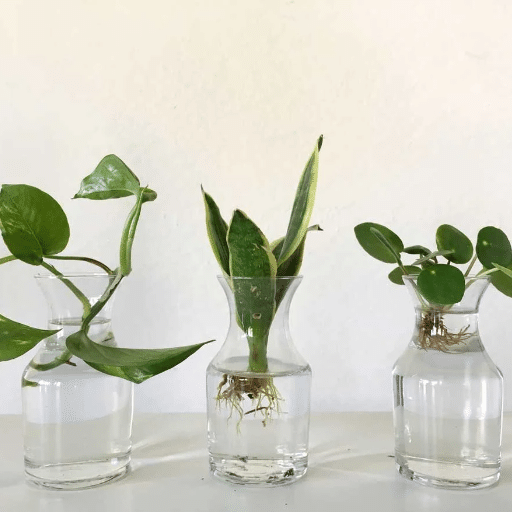Propagating houseplants is such a gratifying and economical way to enlarge a garden either in or outdoors while at the same time spreading some plant cuttings among friends and family members. This comprehensive guide helps you with some of the easier varieties of houseplants to propagate, putting less work while helping create refreshing sights of greenery. Whether you’re an inexperienced gardener or an expert plant lover, you’ll learn step-by-step tips about selecting the correct plants, preparing cuttings, and encouraging healthy growth.
Introduction to Plant Propagation

What is Propagation?
Propagation is creating new plants from existing ones and it is one of the most satisfying ways to make an indoor jungle. Taking cuttings from plants, dividing root systems, or setting seeds are some methods used to induce brand-new plants from a parent plant. This is an easy process that enables you to:
- Save money on new plants
- Experiment with different plant varieties
- Quickly fill up any space with greenery
- Share plants with friends and family
Why Propagate Houseplants?
Propagating houseplants offers multiple benefits:
- Eco-friendly: Gives older plants a new life
- Cost-effective: Saves money while expanding your collection
- Rewarding: Provides a sense of fulfillment watching new growth appear
- Plant health: Great way to prune and rejuvenate plants
- Social sharing: Perfect for sharing the joy of plants with others
Easiest Plants to Propagate – Quick Reference
| Plant Name | Propagation Method | Time to Root | Difficulty Level |
|---|---|---|---|
| Pothos | Stem cuttings in water | 2-3 weeks | Very Easy |
| Spider Plant | Plantlets/Spiderettes | 1-2 weeks | Very Easy |
| Snake Plant | Leaf cuttings or division | 3-4 weeks | Easy |
| ZZ Plant | Stem or leaf cuttings | 4-6 weeks | Easy |
| Succulents | Leaf cuttings | 2-4 weeks | Very Easy |
| African Violet | Leaf cuttings | 6-8 weeks | Moderate |
Top Houseplants Perfect for Cuttings

Pothos: Versatile and Resilient
Pothos ranks high in popularity among novices and experienced plant enthusiasts alike. This versatile plant:
- Survives in most lighting conditions (low light to bright, indirect sunlight)
- Requires minimal watering – wait until top inch of soil feels dry
- Features beautiful trailing vines that can climb or cascade
- Works as a natural air purifier
Spider Plant: An Easy Choice for Beginners
Spider plants are fantastic for beginners due to their adaptable nature. Key features include:
- Arching leaves with spider-like offshoots called “spiderettes”
- Thrives in bright, indirect light but tolerates lower light conditions
- Minimal watering requirements
- Excellent air purifier, removing indoor toxins
Propagation Method: Remove a spiderette, place it in water until roots emerge, then relocate to soil.
African Violet: Leaf Cuttings Made Simple
African violet propagation from leaf cuttings is surprisingly easy and rewarding. Follow these steps:
- Select a healthy, mature leaf free of damage
- Cut the leaf with about an inch of stem at a 45-degree angle
- Use well-draining sterile potting mix (African violet mix or peat moss and perlite)
- Place stem into the soil with leaf slightly angled
- Cover with a plastic bag or clear dome to maintain humidity
- Place in warm, bright spot with indirect light
- Wait 6-8 weeks for new plantlets to emerge
Propagation Methods for Houseplants

Water Propagation: Step-by-Step Guide
Water propagation is simple and effective for many houseplants:
- Choose a healthy stem or leaf cutting
- Make cut just below a node
- Remove leaves from lower portion to prevent underwater rotting
- Place cutting in transparent container with clean water
- Refresh water regularly for oxygen supply
- Position in bright, indirect light
- When roots reach 1-2 inches long, transplant to soil
Stem Cuttings: Professional Tips
Advantages of stem cuttings:
- Creates genetically identical clones of favorite plants
- Preserves specific traits (bloom color, leaf shape, fruit quality)
- Cost-effective alternative to buying new plants
- Faster than growing from seed
Leaf Cuttings: Techniques and Tips
Perfect for plants with fleshy or thick leaves (succulents, African violets):
- Choose healthy, mature leaves free from damage
- Sever leaf at base, cut into sections if plant type allows
- Place in well-draining potting mixture
- Insert cut end slightly into mixture
- Provide indirect light and consistent moisture
- Exercise patience – root growth takes several weeks
Plantlets and Divisions: When to Use
Best for plants that naturally produce offsets, runners, or clumps:
- Spider plants: Remove plantlets along runners once small roots develop
- Ferns and hostas: Divide when overcrowded to promote new growth
- Timing: Early spring or late fall during dormant periods
More Easy-to-Propagate Houseplants

Snake Plant: Low-Maintenance Success
Snake plants (Sansevieria) are truly low-maintenance champions:
- Adapts to both bright and low light conditions
- Water only once every 2-3 weeks
- Continues growing even when occasionally neglected
- Purifies air naturally
- Striking architectural appearance
ZZ Plant: Thriving in Low Light
The ZZ plant excels in challenging indoor conditions:
- Thrives in low-light settings
- Water sparingly every 2-3 weeks
- Allow soil to dry completely between waterings
- Tolerates periods of neglect
- Waxy, emerald-green leaves add glamour to any room
Coleus: Colorful and Easy to Propagate
Coleus provides vibrant color with minimal effort:
- Beautiful multicolored foliage in various patterns
- Colors range from deep purples to bright lime greens
- Propagates easily – roots appear within days in water
- Prefers well-draining soil and regular watering
- Thrives in bright, indirect light
Succulents and Cacti: Special Propagation Tips

Succulent Propagation Method
- Gently twist healthy leaf from base of mother plant
- Allow leaf to callous over for 1-2 days
- Place on bed of well-draining soil
- Within weeks, roots and small rosettes emerge
- Provide moderate watering and bright, indirect light
Cactus Propagation Steps
- Cut piece from parent plant with clean, sharp tool
- Allow cutting to dry for several days to prevent rotting
- Plant in specialized cactus mix
- Water moderately until established
- Exercise patience – these sturdy plants reward proper care
Specialty Trailing Succulents
String of Hearts
- Delicate trailing plant with heart-shaped leaves
- Prefers bright, indirect light
- Water only when soil is bone dry
- Propagate using stem cuttings on moist soil
- Roots typically develop within 2-3 weeks
String of Pearls
- Cut a healthy strand 3-5 inches long
- Remove leaves from the bottom half
- Lay cutting on well-draining succulent soil
- Ensure nodes contact the soil surface
- Roots form in 2-4 weeks with proper care
Jade Plants: Dual Propagation Methods
Stem Cutting Method:
- Select healthy stem and cut below node
- Allow cutting to dry for 1-2 days
- Place in well-draining soil
- Keep slightly moist until roots appear (2-3 weeks)
Leaf Cutting Method:
- Choose mature leaf detached cleanly from stem
- Lay on top of soil with base touching surface
- Keep lightly moist under bright, indirect light
- Practice patience for rewarding results
References
-
Epic Gardening: This article lists 17 houseplants that are particularly easy to propagate, including succulents like Echeverias. Epic Gardening – Easy-to-Propagate Houseplants1.
-
Iowa State University Extension and Outreach: This resource offers detailed guidance on propagating houseplants, including popular options like Pothos, Snake Plants, and Spider Plants. Yard and Garden – Propagating Houseplants2.
-
Rural Sprout: This article highlights 9 houseplants that are simple to propagate, such as Tradescantia, Aloe Vera, and Pothos. Rural Sprout – Easy-to-Propagate Houseplants3.
Frequently Asked Questions (FAQ)
How can I propagate a spider plant?
It is really easy to propagate a spider plant via its offshoots, sometimes called “pups.” The pup grows attached to the mother plant and can be disconnected when it is a few inches tall. Just take a cutting of the pup that has some root and place it in water or potting soil. Keep it in a warm and bright place, watering it from time to time to keep the soil moist. New leaves will appear in a few weeks as proof that your baby plant is doing well.
What is the best way to propagate a pothos?
Quite easy, actually, and this is why so many indoor gardeners love it. To propagate the pothos, take a cutting that has at least one node, as root growth happens here. The cutting can be placed in a container of clean water and allowed to grow roots for a few weeks. When the roots grow a few inches long, the cutting can then be planted into potting soil for further development. Propagating plants in this manner is an easy way to rapidly increase your plant numbers given that you can propagate multiple cuttings at once.
Can you propagate an african violet from leaf cuttings?
Yes, African violets can be propagated from leaf cuttings, which is a rewarding method for many. Give the mother plant a careful single leaf cutting together with its petiole. If using water, place the leaf cutting in a container of water or plant it directly in potting soil. Keep the soil moist and provide the right humidity conditions to stimulate root growth. In just a few weeks, you will likely observe baby plants developing at the base of the leaf, indicating successful propagation.
What is the propagation method for a snake plant?
Propagating your snake plant is fairly easy and can be done either through leaf cuttings or division. To do the leaf cuttings, take a healthy leaf and cut it into several sections, each about 4-6 inches long. Allow the cuttings to callous over for one to two days and then place the cuttings in a container of soil or water. For the division method, just remove the plant from its pot, then divide the root into sections that each have a few leaves attached. Both methods will result in new plants that root quickly and are easy to care for.
How do you propagate a zz plant?
In propagating zz plants, you have some options: stem cuttings and leaf cuttings, both of which are quite simple. Start with stem cuttings by taking a healthy stem from the mother plant; cut the stem into sections. Allow to dry for a few hours and then plant them in a container filled with potting soil. You can also propagate using leaf cuttings: plant one leaf in soil and keep it moist. After several weeks, roots will form, and the new plant will be ready to grow.
What type of potting soil is best for propagating succulents?
Well-draining potting soil is always great for propagating succulents, especially designed for cacti and succulents. This type of soil allows excess moisture to evaporate, and this is very important in keeping the roots from rotting. Alternatively, if one wants to make his or her own, they can mix regular potting soil with sand or perlite to increase drainage. During propagation, keep the succulent cuttings in a dry place for just a few days before watering, allowing for the cut ends to callous. This helps to create strong roots for your new plants.





